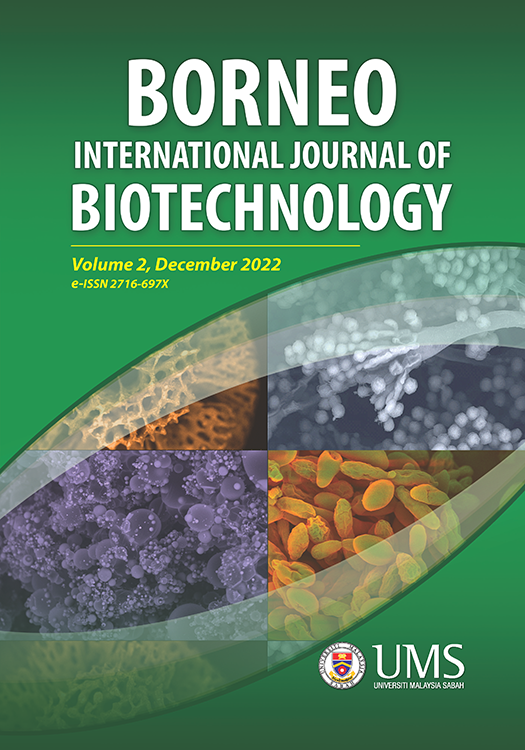Effects of light on phytochemical contents of Brassica rapa under controlled environments
DOI:
https://doi.org/10.51200/bijb.v2i.3409Keywords:
artificial light, Brassica rapa, gas chromatography-mass spectrometry (GCMS), indoor farming, secondary metabolitesAbstract
Plant growth is predominantly influenced by light, and light intensity is manipulated in indoor farming to allow for mass production. The light-emitting diode (LED) is the most practical artificial light, capable of improving crop quality and making indoor agricultural
systems more sustainable. Despite their consistent growth under artificial light, little is known about how light intensities and spectrums affect secondary metabolites in commonly grown Brassica species. This study aimed to compare the metabolite profiles of Brassica rapa (Chinese cabbage) grown under natural light to those grown under different artificial light intensities and spectrums using gas chromatographymass spectrometry (GC-MS). Although the biochemical composition of B. rapa was comparable under varied light conditions, exposure to magenta and red spectrums produced neophytadiene and myristic acid, respectively, whereas exposure to natural light produced squalene and sulfurous acid. Neophytadiene and myristic acid are antioxidants and flavour enhancers, respectively; whereas squalene and sulphurous acid are involved in odour production and function as disinfectants in plants. As a result, these findings add to our understanding of how light conditions can be controlled to improve the growth and biochemical composition of B. rapa, thereby enhancing the palatability of indoor farming.
References
Bures, S., Urrestarazu, M., & Kotiranta, S. (2018). Technical Article: Artificial lighting in agriculture. Biblioteca Horticultura. https://www.bibliotecahorticultura.com/publicaciones/sostenibilidad/artificial-light-in-agriculture/
Castle, M. H., Lubben, B. D., & Luck, J. D. (2016). Factors influencing the adoption of precision agriculture technologies by Nebraska Producers. Presentations, Working Papers, and Gray Literature: Agricultural Economics, p. 49. https://digitalcommons.unl.edu/
ageconworkpap/49
Dou, H., Niu, G., Gu, M., & Masabni, J. G. (2017). Effects of light quality on growth and phytonutrient accumulation of herbs under controlled environments. Horticulturae, 3 (2), 1 – 11. https://doi.org/10.3390/horticulturae3020036
Feng, L., Raza, M. A., Li, Z., Chen, Y., Khalid, M. H., Du, J., Liu, W., Wu, X., Song, C., Yu, L., Zhang, Z., Yuan, S., Yang, W., & Yang, F. (2019). The influence of light intensity and leaf movement on photosynthesis characteristics and carbon balance of soybean. Frontiers in Plant
Science, 9, 1952. https://doi.org/10.3389/fpls.2018.01952
Goff, S. A., & Klee, H. J. (2006). Plant volatile compounds: sensory cues for health and nutritional value? Science, 311 (5762), 815 – 819. https://doi.org/10.1126/science.1112614
Isah, T. (2019). Stress and defense responses in plant secondary metabolites production. Biological Research, 52 (1), 39. https://doi.org/10.1186/s40659-019-0246-3
Jain, C., Khatana, S., & Vijayvergia, R. (2019). Bioactivity of secondary metabolites of various plants: a review. International Journal of Pharmaceutical Sciences and Research, 10 (2), 494 – 504. https://doi.org/10.13040/IJPSR.0975-8232.10(2).494-04
Kachroo, A., & Kachroo, P. (2009). Fatty acid-derived signals in plant defense. Annual Review of Phytopathology, 47, 153 – 176. https://doi.org/10.1146/annurev-phyto-080508-081820
Murashige, T., & Skoog, F. (1962). A revised medium for rapid growth and bioassays with tobacco tissue cultures. Physiol. Plant, 15, 473 – 497. https://doi.org/10.1111/j.1399-3054.1962.tb08052.x
R Core Team. (2016). R: A language and environment for statistical computing. R Foundation for Statistical Computing. https://www.r-project.org/
Ramya, B., Malarvili, T., & Velavan, S. (2015) GC-MS analysis of bioactive compounds in Byronopsis Laciniosa fruit extract. International Journal of Pharmaceutical Sciences and Research, 12, 3375 – 3379. https://doi.org/10.13040/IJPSR.0975-8232.6(8).3375-79
Shamshiri, R., Kalantari, F., Ting, K. C., Thorp, K. R., Hameed, I. A., Weltzien, C., Ahmad, D., & Shad, Z. M. (2018). Advances in greenhouse automation and controlled environment agriculture: A transition to plant factories and urban agriculture. International Journal Agricultural and Biological Engineering, 11 (1), 1 – 22. https://doi.org/10.25165/j.ijabe.20181101.3210
Tholl, D. (2015). Biosynthesis and biological functions of terpenoids in plants. In J. Schrader & J. Bohlmann (Eds.), Biotechnology of isoprenoids: Advances in biochemical engineering/biotechnology (Vol. 148, pp. 63 – 106). Springer. https://doi.org/10.1007/10_2014_295
Thoma, F., Somborn-Schulz, A., Schlehuber, D., Keuter, V., & Deerberg, G. (2020). Effects of light on secondary metabolites in selected leafy greens: A review. Frontiers in Plant Science, 11, 497. https://doi.org/10.3389/fpls.2020.00497
Varsha, K. K., Devendra, L., Shilpa, G., Priya, S., Pandey, A., & Nampoothiri, K. M. (2015). 2,4-Ditert-butyl phenol as the antifungal, antioxidant bioactive purified from a newly isolated Lactococcus sp. International Journal of Food Microbiology, 211, 44 – 50. https://doi.org/10.1016/j.ijfoodmicro.2015.06.025






